2007 FIAT SEDICI engine
[x] Cancel search: enginePage 132 of 266
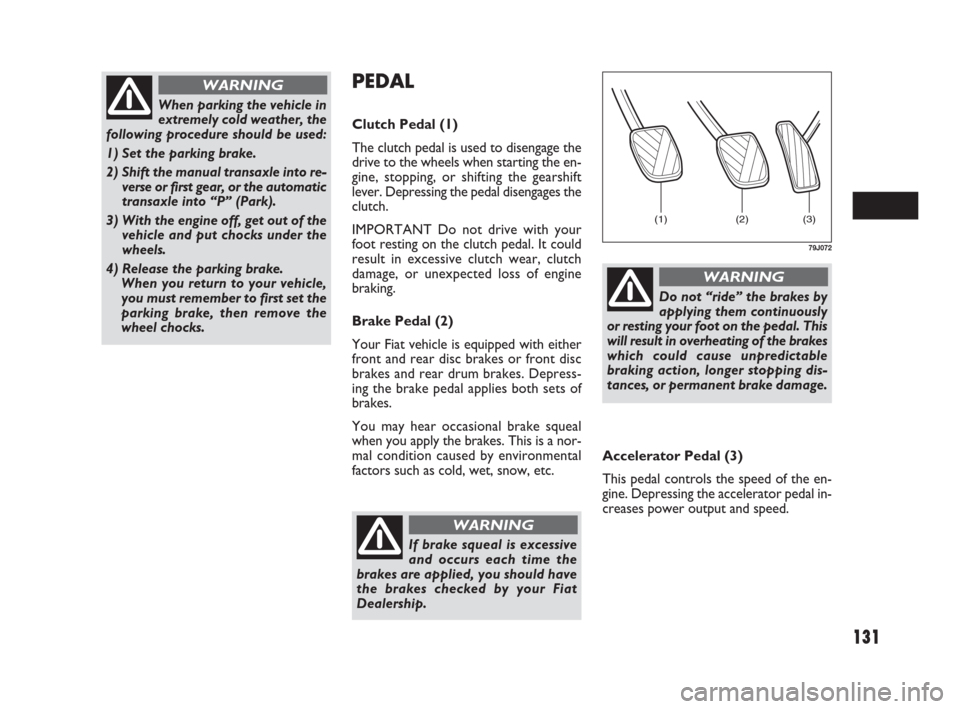
131
PEDAL
Clutch Pedal (1)
The clutch pedal is used to disengage the
drive to the wheels when starting the en-
gine, stopping, or shifting the gearshift
lever. Depressing the pedal disengages the
clutch.
IMPORTANT Do not drive with your
foot resting on the clutch pedal. It could
result in excessive clutch wear, clutch
damage, or unexpected loss of engine
braking.
Brake Pedal (2)
Your Fiat vehicle is equipped with either
front and rear disc brakes or front disc
brakes and rear drum brakes. Depress-
ing the brake pedal applies both sets of
brakes.
You may hear occasional brake squeal
when you apply the brakes. This is a nor-
mal condition caused by environmental
factors such as cold, wet, snow, etc.Accelerator Pedal (3)
This pedal controls the speed of the en-
gine. Depressing the accelerator pedal in-
creases power output and speed.
When parking the vehicle in
extremely cold weather, the
following procedure should be used:
1) Set the parking brake.
2) Shift the manual transaxle into re-
verse or first gear, or the automatic
transaxle into “P” (Park).
3) With the engine off, get out of the
vehicle and put chocks under the
wheels.
4) Release the parking brake.
When you return to your vehicle,
you must remember to first set the
parking brake, then remove the
wheel chocks.
WARNING
(1) (2) (3)
79J072
If brake squeal is excessive
and occurs each time the
brakes are applied, you should have
the brakes checked by your Fiat
Dealership.
WARNING
Do not “ride” the brakes by
applying them continuously
or resting your foot on the pedal. This
will result in overheating of the brakes
which could cause unpredictable
braking action, longer stopping dis-
tances, or permanent brake damage.
WARNING
129-148 Fiat16 New GB 27-11-2007 11:27 Pagina 131
Page 141 of 266
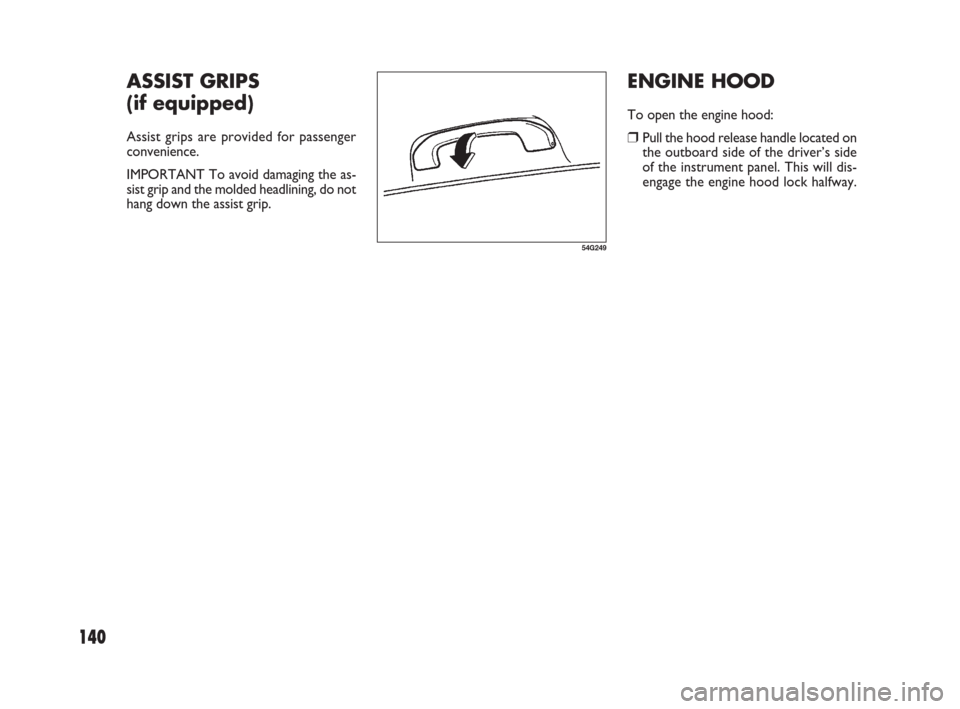
ENGINE HOOD
To open the engine hood:
❒Pull the hood release handle located on
the outboard side of the driver’s side
of the instrument panel. This will dis-
engage the engine hood lock halfway.
140
ASSIST GRIPS
(if equipped)
Assist grips are provided for passenger
convenience.
IMPORTANT To avoid damaging the as-
sist grip and the molded headlining, do not
hang down the assist grip.
54G249
129-148 Fiat16 New GB 27-11-2007 11:27 Pagina 140
Page 142 of 266
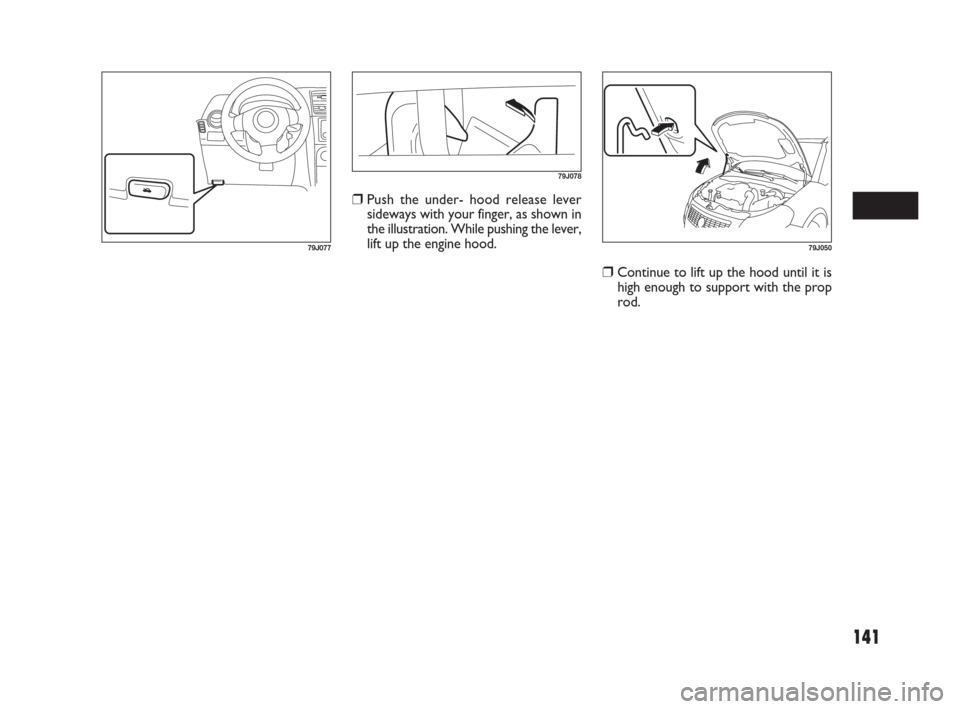
141
❒Push the under- hood release lever
sideways with your finger, as shown in
the illustration. While pushing the lever,
lift up the engine hood.
❒Continue to lift up the hood until it is
high enough to support with the prop
rod.
79J07779J050
79J078
129-148 Fiat16 New GB 27-11-2007 11:27 Pagina 141
Page 150 of 266
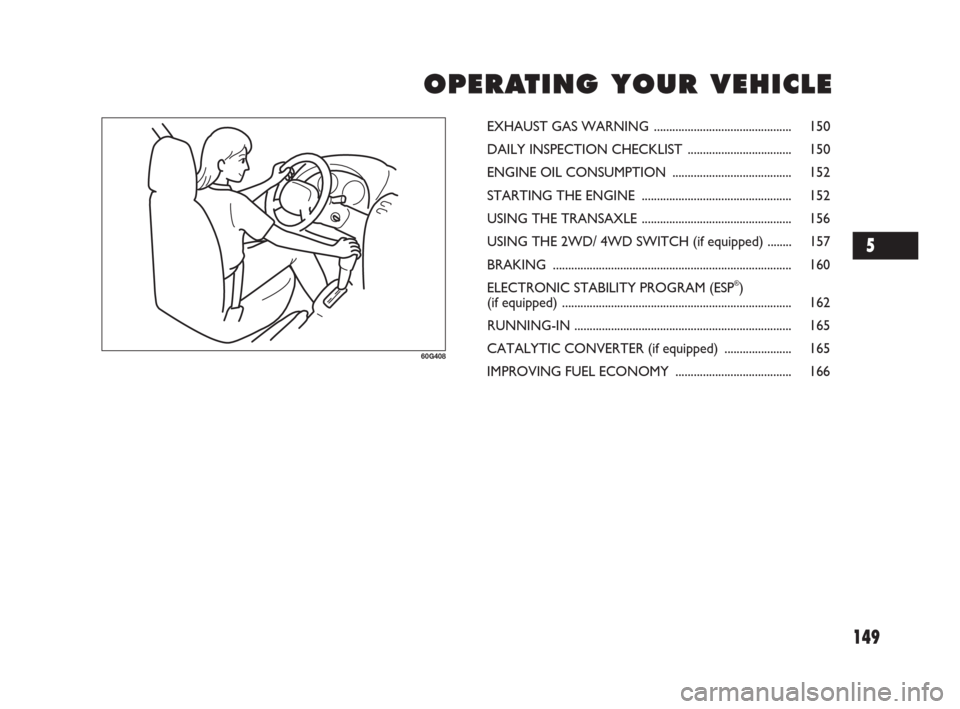
149
O O
P P
E E
R R
A A
T T
I I
N N
G G
Y Y
O O
U U
R R
V V
E E
H H
I I
C C
L L
E E
60G408
EXHAUST GAS WARNING ............................................. 150
DAILY INSPECTION CHECKLIST .................................. 150
ENGINE OIL CONSUMPTION ....................................... 152
STARTING THE ENGINE ................................................. 152
USING THE TRANSAXLE ................................................. 156
USING THE 2WD/ 4WD SWITCH (if equipped) ........ 157
BRAKING .............................................................................. 160
ELECTRONIC STABILITY PROGRAM (ESP
®)
(if equipped) ........................................................................... 162
RUNNING-IN ....................................................................... 165
CATALYTIC CONVERTER (if equipped)...................... 165
IMPROVING FUEL ECONOMY ...................................... 166
5
149-166 Fiat16 New GB 27-11-2007 11:27 Pagina 149
Page 151 of 266
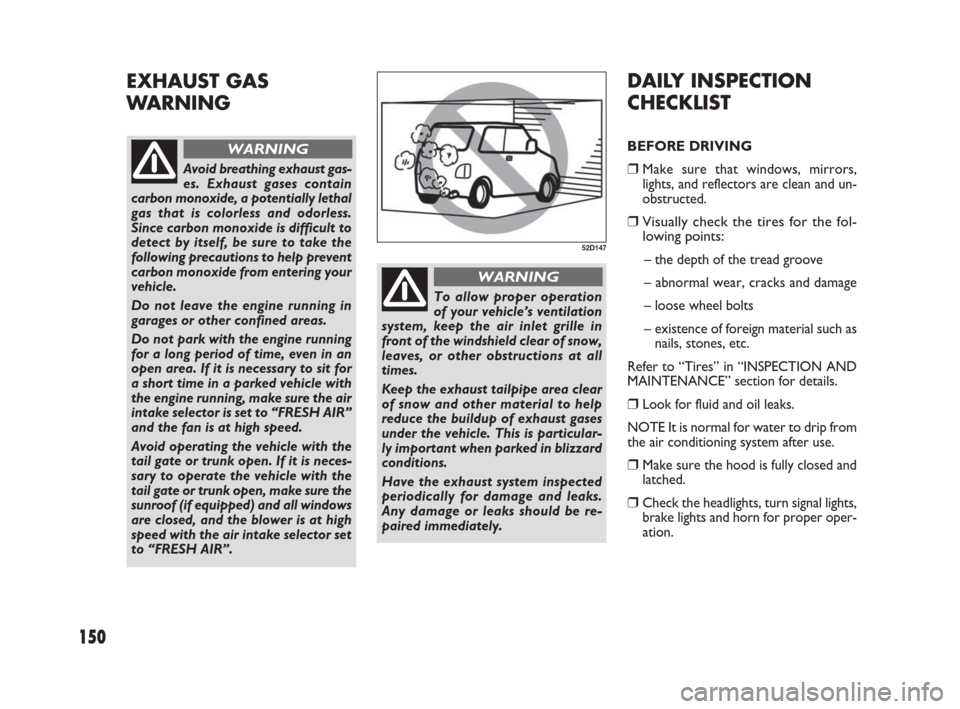
150
DAILY INSPECTION
CHECKLIST
BEFORE DRIVING
❒Make sure that windows, mirrors,
lights, and reflectors are clean and un-
obstructed.
❒Visually check the tires for the fol-
lowing points:
– the depth of the tread groove
– abnormal wear, cracks and damage
– loose wheel bolts
– existence of foreign material such as
nails, stones, etc.
Refer to “Tires” in “INSPECTION AND
MAINTENANCE” section for details.
❒Look for fluid and oil leaks.
NOTE It is normal for water to drip from
the air conditioning system after use.
❒Make sure the hood is fully closed and
latched.
❒Check the headlights, turn signal lights,
brake lights and horn for proper oper-
ation.
EXHAUST GAS
WARNING
52D147
Avoid breathing exhaust gas-
es. Exhaust gases contain
carbon monoxide, a potentially lethal
gas that is colorless and odorless.
Since carbon monoxide is difficult to
detect by itself, be sure to take the
following precautions to help prevent
carbon monoxide from entering your
vehicle.
Do not leave the engine running in
garages or other confined areas.
Do not park with the engine running
for a long period of time, even in an
open area. If it is necessary to sit for
a short time in a parked vehicle with
the engine running, make sure the air
intake selector is set to “FRESH AIR”
and the fan is at high speed.
Avoid operating the vehicle with the
tail gate or trunk open. If it is neces-
sary to operate the vehicle with the
tail gate or trunk open, make sure the
sunroof (if equipped) and all windows
are closed, and the blower is at high
speed with the air intake selector set
to “FRESH AIR”.
WARNING
To allow proper operation
of your vehicle’s ventilation
system, keep the air inlet grille in
front of the windshield clear of snow,
leaves, or other obstructions at all
times.
Keep the exhaust tailpipe area clear
of snow and other material to help
reduce the buildup of exhaust gases
under the vehicle. This is particular-
ly important when parked in blizzard
conditions.
Have the exhaust system inspected
periodically for damage and leaks.
Any damage or leaks should be re-
paired immediately.
WARNING
149-166 Fiat16 New GB 27-11-2007 11:27 Pagina 150
Page 152 of 266
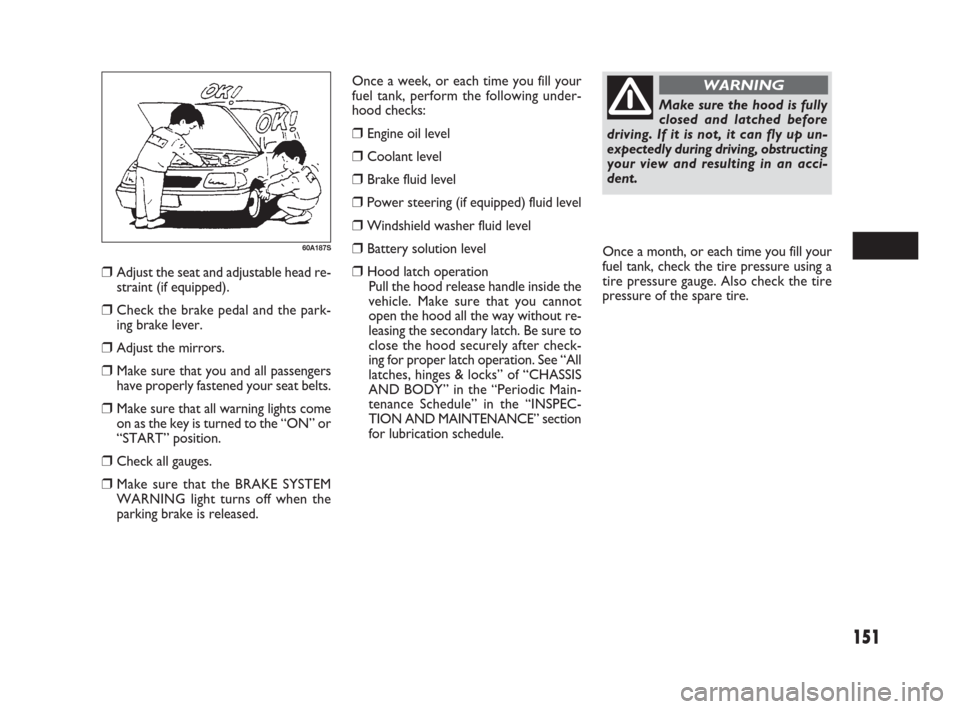
151
Once a week, or each time you fill your
fuel tank, perform the following under-
hood checks:
❒Engine oil level
❒Coolant level
❒Brake fluid level
❒Power steering (if equipped) fluid level
❒Windshield washer fluid level
❒Battery solution level
❒Hood latch operation
Pull the hood release handle inside the
vehicle. Make sure that you cannot
open the hood all the way without re-
leasing the secondary latch. Be sure to
close the hood securely after check-
ing for proper latch operation. See “All
latches, hinges & locks” of “CHASSIS
AND BODY” in the “Periodic Main-
tenance Schedule” in the “INSPEC-
TION AND MAINTENANCE” section
for lubrication schedule.Once a month, or each time you fill your
fuel tank, check the tire pressure using a
tire pressure gauge. Also check the tire
pressure of the spare tire.❒Adjust the seat and adjustable head re-
straint (if equipped).
❒Check the brake pedal and the park-
ing brake lever.
❒Adjust the mirrors.
❒Make sure that you and all passengers
have properly fastened your seat belts.
❒Make sure that all warning lights come
on as the key is turned to the “ON” or
“START” position.
❒Check all gauges.
❒Make sure that the BRAKE SYSTEM
WARNING light turns off when the
parking brake is released.
60A187S
Make sure the hood is fully
closed and latched before
driving. If it is not, it can fly up un-
expectedly during driving, obstructing
your view and resulting in an acci-
dent.
WARNING
149-166 Fiat16 New GB 27-11-2007 11:27 Pagina 151
Page 153 of 266
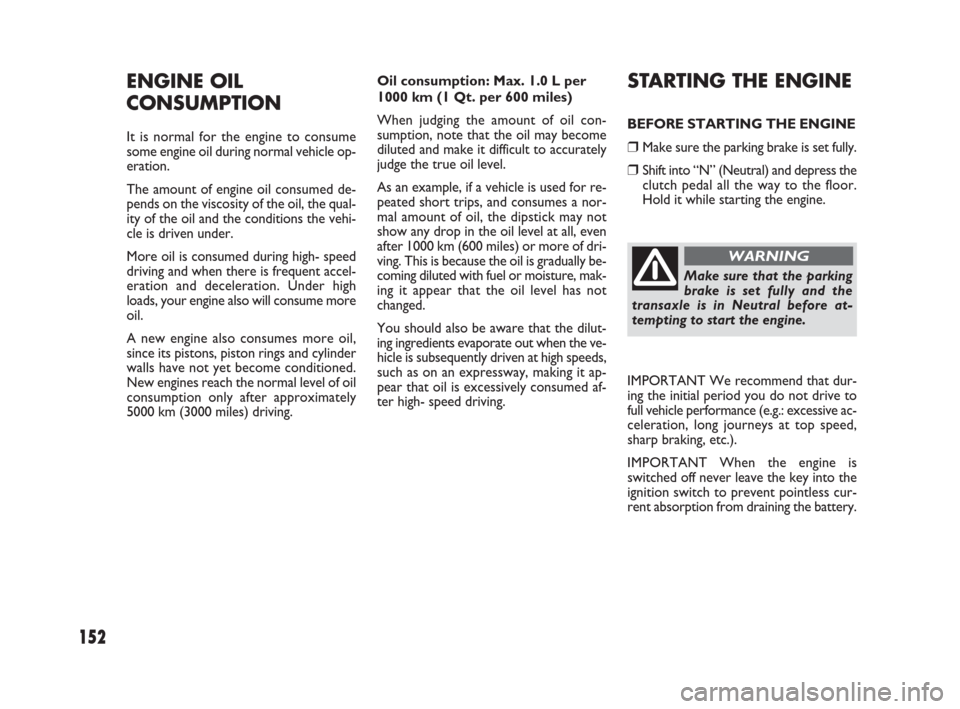
152
Oil consumption: Max. 1.0 L per
1000 km (1 Qt. per 600 miles)
When judging the amount of oil con-
sumption, note that the oil may become
diluted and make it difficult to accurately
judge the true oil level.
As an example, if a vehicle is used for re-
peated short trips, and consumes a nor-
mal amount of oil, the dipstick may not
show any drop in the oil level at all, even
after 1000 km (600 miles) or more of dri-
ving. This is because the oil is gradually be-
coming diluted with fuel or moisture, mak-
ing it appear that the oil level has not
changed.
You should also be aware that the dilut-
ing ingredients evaporate out when the ve-
hicle is subsequently driven at high speeds,
such as on an expressway, making it ap-
pear that oil is excessively consumed af-
ter high- speed driving.STARTING THE ENGINE
BEFORE STARTING THE ENGINE
❒Make sure the parking brake is set fully.
❒Shift into “N” (Neutral) and depress the
clutch pedal all the way to the floor.
Hold it while starting the engine.
ENGINE OIL
CONSUMPTION
It is normal for the engine to consume
some engine oil during normal vehicle op-
eration.
The amount of engine oil consumed de-
pends on the viscosity of the oil, the qual-
ity of the oil and the conditions the vehi-
cle is driven under.
More oil is consumed during high- speed
driving and when there is frequent accel-
eration and deceleration. Under high
loads, your engine also will consume more
oil.
A new engine also consumes more oil,
since its pistons, piston rings and cylinder
walls have not yet become conditioned.
New engines reach the normal level of oil
consumption only after approximately
5000 km (3000 miles) driving.
Make sure that the parking
brake is set fully and the
transaxle is in Neutral before at-
tempting to start the engine.
WARNING
IMPORTANT We recommend that dur-
ing the initial period you do not drive to
full vehicle performance (e.g.: excessive ac-
celeration, long journeys at top speed,
sharp braking, etc.).
IMPORTANT When the engine is
switched off never leave the key into the
ignition switch to prevent pointless cur-
rent absorption from draining the battery.
149-166 Fiat16 New GB 27-11-2007 11:27 Pagina 152
Page 154 of 266
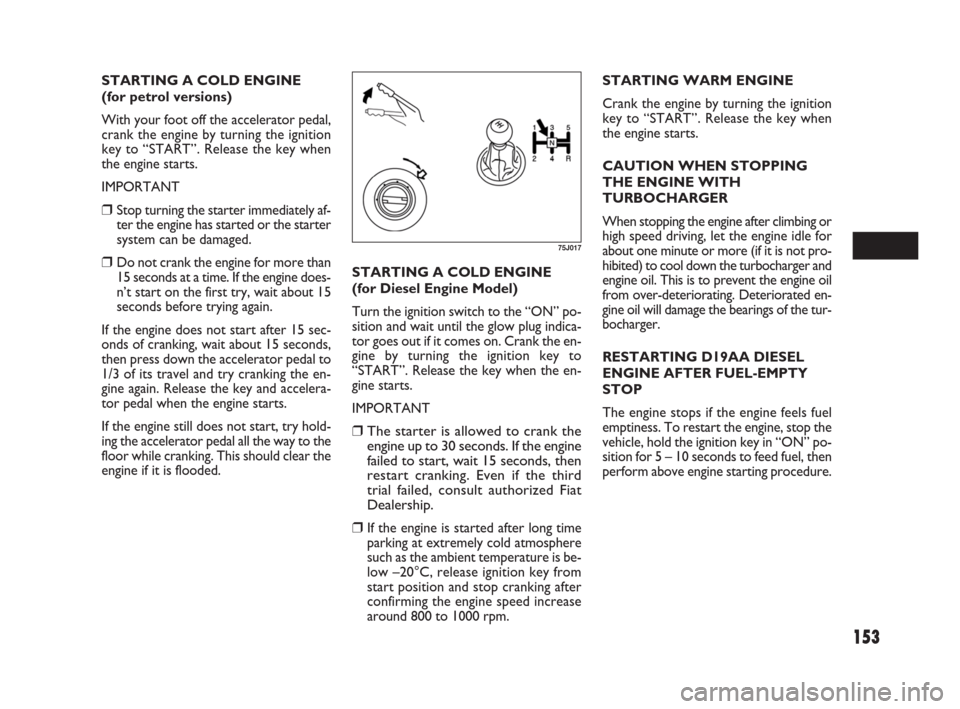
153
STARTING A COLD ENGINE
(for petrol versions)
With your foot off the accelerator pedal,
crank the engine by turning the ignition
key to “START”. Release the key when
the engine starts.
IMPORTANT
❒Stop turning the starter immediately af-
ter the engine has started or the starter
system can be damaged.
❒Do not crank the engine for more than
15 seconds at a time. If the engine does-
n’t start on the first try, wait about 15
seconds before trying again.
If the engine does not start after 15 sec-
onds of cranking, wait about 15 seconds,
then press down the accelerator pedal to
1/3 of its travel and try cranking the en-
gine again. Release the key and accelera-
tor pedal when the engine starts.
If the engine still does not start, try hold-
ing the accelerator pedal all the way to the
floor while cranking. This should clear the
engine if it is flooded.
75J017
STARTING A COLD ENGINE
(for Diesel Engine Model)
Turn the ignition switch to the “ON” po-
sition and wait until the glow plug indica-
tor goes out if it comes on. Crank the en-
gine by turning the ignition key to
“START”. Release the key when the en-
gine starts.
IMPORTANT
❒The starter is allowed to crank the
engine up to 30 seconds. If the engine
failed to start, wait 15 seconds, then
restart cranking. Even if the third
trial failed, consult authorized Fiat
Dealership.
❒
If the engine is started after long time
parking at extremely cold atmosphere
such as the ambient temperature is be-
low –20°C, release ignition key from
start position and stop cranking after
confirming the engine speed increase
around 800 to 1000 rpm.STARTING WARM ENGINE
Crank the engine by turning the ignition
key to “START”. Release the key when
the engine starts.
CAUTION WHEN STOPPING
THE ENGINE WITH
TURBOCHARGER
When stopping the engine after climbing or
high speed driving, let the engine idle for
about one minute or more (if it is not pro-
hibited) to cool down the turbocharger and
engine oil. This is to prevent the engine oil
from over-deteriorating. Deteriorated en-
gine oil will damage the bearings of the tur-
bocharger.
RESTARTING D19AA DIESEL
ENGINE AFTER FUEL-EMPTY
STOP
The engine stops if the engine feels fuel
emptiness. To restart the engine, stop the
vehicle, hold the ignition key in “ON” po-
sition for 5 – 10 seconds to feed fuel, then
perform above engine starting procedure.
149-166 Fiat16 New GB 27-11-2007 11:27 Pagina 153